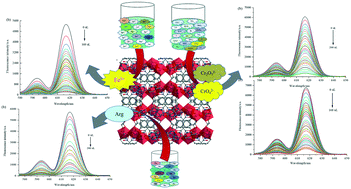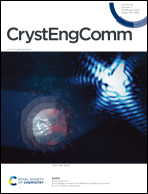A highly stable Eu-MOF multifunctional luminescent sensor for the effective detection of Fe3+, Cr2O72−/CrO42− and aspartic acid in aqueous systems†
Abstract
Heavy metal ions are common pollutants in water pollution. Amino acids, as important substances in organisms, participate in many life activities. The detection of heavy metal ions and amino acids with high selectivity and sensitivity is important. Therefore, based on H3L (H3L = 4,4′,4′′-triazine-2,4,6-tribenzoic acid) and Eu3+, an Eu-MOF was designed, synthesized and characterized. Single crystal structure analysis showed that the Eu-MOF was crystallized in the orthorhombic space group Fddd, and presents a three-dimensional (3D) porous network structure. The luminescence results show that the Eu-MOF has good luminescence stability. As a multifunctional luminescent sensor, the Eu-MOF can detect Fe3+, Cr2O72−, CrO42− and aspartic acid (Asp) in water systems with high sensitivity and selectivity, and the lowest detection limit (LOD) was 1.12 × 10−6 mol L−1, 1.95 × 10−6 mol L−1, 1.89 × 10−6 mol L−1 and 2.20 × 10−6 mol L−1, respectively. These results indicated that the Eu-MOF has potential application prospects in the detection of Fe3+, Cr2O72−, CrO42− and Asp in water.



 Please wait while we load your content...
Please wait while we load your content...